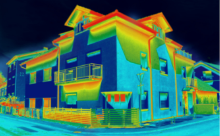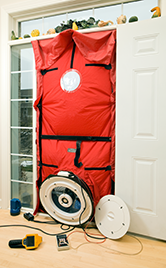
The energy used in our buildings accounts for about a third of the region’s community greenhouse gas emissions.
A great way to reduce our emissions is by using renewable energy to heat our homes by installing retrofits like heat pumps or solar panels. We can also improve the energy efficiency of new buildings and retrofit existing buildings to be more climate-friendly.
These steps will reduce the carbon footprint of our homes and workplaces and will also make our buildings more comfortable and lower our energy bills. Adapting our buildings to a changing climate will help us manage the impacts of climate change. Read more >>
Taking action at home to reduce energy and fossil fuel use and prepare for climate-related impacts are important ways that the capital region can be a part of the global climate solution.
The Home Energy Navigator program helps homeowners take the next step, regardless of where they’re in their retrofit journey, and aims to reduce barriers to completing a home energy retrofit. This new regional service provides participants with free support from local energy experts, including:
- Rebate navigation
- Virtual home energy consultation
- Quote reviews
- Customized retrofit roadmap
- And more!
If you have questions regarding rebate requirements or need support with deciding which upgrades are right for your home, reviewing quotes or filling out your rebate applications, you’re not alone! You can participate in the program for free by filling out a registration form at www.homeenergynav.ca or calling 1.866.381.9995.
The Home Energy Navigator Program is a free program created by the CRD and local government partners in the capital region and informed by industry experts, including numerous local contractors. It is being executed by City Green Solutions, a local non-profit with decades of experience helping homeowners save energy.
Borrow a Climate Action To-Go Kit from your local library and discover how you can take climate action in your home. Each kit contains resources and activities for you to:
- Measure household appliance electricity use with a Kill-A-Watt meter
- Discover air leaks in walls and around windows using a thermal leak detector
- Measure your home’s optimal lighting using a digital illuminance light meter
Read more >>
The CRD is taking steps to reduce operational GHG emissions from its facilities. In 2019, GHG emissions from buildings, facilities, and infrastructure have decreased by 21% since 2007, despite adding new buildings and facilities. The CRD continues to look for opportunities to minimize GHG emissions and energy use, such as upgrading to high-efficiency natural gas boilers, and investigating the waste heat recovery projects at Panorama Recreation and SEAPARC. To learn more, see our Climate Action Strategy and annual reports.
Energy Step Code

As of May 1, 2023 the BC Energy Step Code is the default compliance path for energy efficiency in the BC Building Code. The Step Code that establishes progressive performance steps in energy efficiency for new buildings from the current BC Building Code level to net zero energy ready buildings by 2030. Each “step” of the code representing increasing levels of energy-efficiency performance and applies to new construction only.
Several municipalities in the CRD have adopted higher steps of the Step Code. More information on municipal adoption of the Step Code is available here: Implementation updates | Energy Step Code.
What are the Provincial Timelines for BC Energy Step Code adoption?
The CleanBC Plan and subsequent Roadmap to 2030 set the provincial adoption schedule for the Step Code, with a proposed implementation timeline as follows:
- May 1, 2023 BC Building Code Update – Step 3 (part 9) and Step 2 (part 3 most occupancies)
- 2027 BC Building Code Update – Step 4 (part 9) and Step 3 (part 3 residential)
- 2030 BC Building Code Update – Step 5 (part 9) and Step 4 (Part 3 residential)
How does this relate to Carbon Pollution?
While the Energy Step Code focuses on energy efficiency, with the most recent updates to the BC Building code, the Province has included new optional powers that local governments can use to directly regulate carbon pollution from new buildings. This new Zero Carbon Step Code creates four steps:
- Measure only – which requires modeled emission reporting as part of permitting
- Moderate Carbon Performance – which would usually require the decarbonization of either the building space or water heating systems
- Strong Carbon Performance – which would usually require the decarbonization of both the building space and water heating systems
- Zero Carbon Performance – which would usually require the decarbonization of all building energy systems.
As of May 1, 2023 the District of Saanich and the City of Victoria have enacted this new power in their jurisdictions. City of Colwood and the District of Central Saanich have moved to incentivize zero carbon construction.
Benefits of Step Code
Building more efficient buildings has many benefits for building owners and tenants, industry, and our environment.
- Reduced energy use, resulting in decreased utility bills
- Improved temperature control, comfort, air quality and health
- Improved soundproofing
- Positioning BC as leader in green building design and construction, creating jobs and local economic development opportunities
Helpful Links & Resources
For questions about the Energy Step Code or to contact the Energy Step Code Council, please
email the Province’s Building and Safety Standards Branch. For questions about the Energy Step Code in the capital region please
contact us.